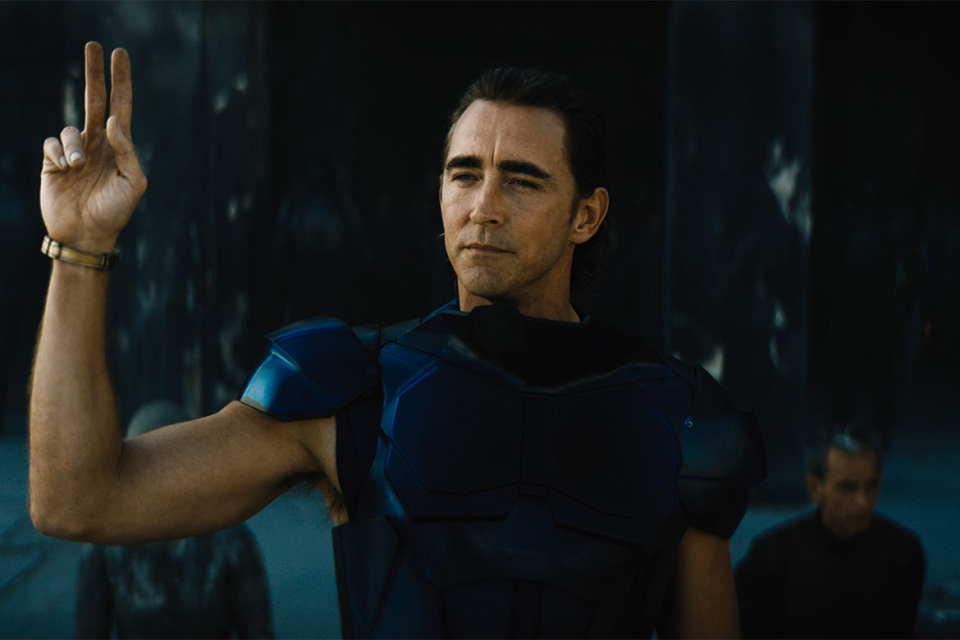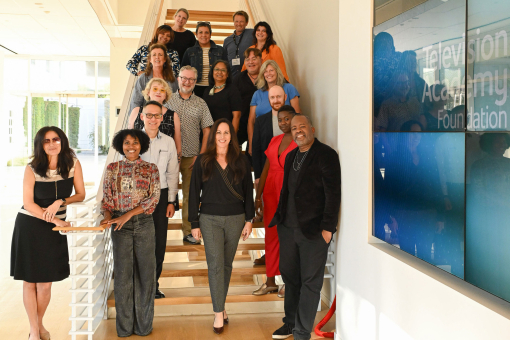Isaac Asimov’s Foundation novels started as a series of short stories in 1942, and expanded to a trilogy in 1951-53. It remained a trilogy for many years, until the science-fiction master began adding to the story in the 1980s, finally merging it with his equally famous Robot series.
Now, in the 21st century, the saga finally comes to television with the Apple TV+ series Foundation, premiering on Friday, September 24.
Asimov’s Foundation trilogy begins on the planet Trantor with the story of Hari Seldon (Jared Harris) and his protegée Gaal Dornick (newcomer Lou Llobell) who comes from the water planet of Synnax to work with Seldon.
Seldon is a pioneer in the field of “psychohistory,” a mathematical construct that can predict the likely future of the Galactic Empire.
In his calculations, Seldon has discovered that the empire is collapsing and will be destroyed in five centuries, after which a dark age lasting 30,000 years will ensue. He proposes the creation of a Foundation to create the Encyclopedia Galactica, preserving the stories and knowledge of civilization for the purpose of shortening the dark age to only one millennium.
The empire is ruled by a triad, Brother Dusk (Terrence Mann), Brother Day (Lee Pace), and Brother Dawn (Cassian Bilton). The three take exception to Seldon’s predictions, and, as the story begins, are about to execute him and Gaal. However, when events begin to prove Seldon’s predictions may be correct, they instead help him to set up the Foundation on the planet Terminus.
Previous attempts to adapt the material for film and television were unsuccessful, but executive producer and showrunner David S. Goyer thinks this is the right time to bring the story to TV audiences.
“I think the medium has matured to the point at which the story could be told,” he says. “Most of the previous attempts were attempts to encapsulated or compress it down into a feature film or a series of features. I myself was offered the opportunity to adapt it twice as a feature earlier on in my career.
“But with the advent of some of the more novelistic serialized shows that you're seeing on the streamers — all the streamers tend to have their two or three tentpole shows — they are the kind of epics that people are going to dig into over the course of multiple seasons and episodes. I feel like the audience and the medium have matured to a point at which an adaptation like this is now possible.
"And there are also technological advances that make it possible that didn't exist even 10 years ago. And just personally as a writer, I think I've matured to the point at which maybe now I can handle adapting it.”
Over the course of three decades in Hollywood, Goyer has become one of industry’s premier writers in the fantasy, science fiction, and comic genres. His credits include several films (Blade, Batman Begins, The Dark Knight, Man of Steel) and television series (Constantine, Da Vinci’s Demons, the upcoming Sandman). So, when the rights became available for Foundation, Goyer was prepared to take it on.
Knowing the popularity of the novels and the attachment science fiction fans have to the material, Goyer knew he would have to be careful in his approach, without being bound to the original material. “You have to honor it,” he says. “I don't think it's possible to adapt something like this unless you really love it, and revere it.
“The one benefit we had is that it had never been visualized before,” he continues, “so people didn't have any preconception of what Trantor would look like or the vault or the prime radiant or Hari Seldon. But the other thing that you have to realize is that Asimov was using science fiction as an allegory to talk about his contemporary world, which was a post-World War II environment, the empires that were falling.
“It was the realignment in Europe and the ascendancy of America. That's not the world that exists today. So the people who are going to consume the show — and hopefully like the show — may not have read the books. They're not living in that world 70 years ago. So if we're using Asimov's words and science fiction to tell an allegory about our world today, it necessitates change.
“I’m going to be talking about a post-9/11 world, I'm going to be talking about nationalism, and #MeToo, and Brexit. These are the things that are concerning the world right now. I didn't imagine I would be talking about a global pandemic. All of these scripts were written well before the pandemic hit. But they've become oddly prescient now that the pandemic has happened.
"Asimov's point was that history and humanity are cyclical. Obviously, we had the flu pandemic in 1917, and a lot of the things that we were dealing with 100 years ago, we're wrestling with today.
“I would argue that Foundation is more relevant today than it was even when Asimov was writing it. It's certainly more relevant today than when we started adapting it three years ago — eerily so. But that having been said, an audience doesn't want to feel like they're being preached to. You have to entertain people first. Maybe slip a little bit of medicine in with the sugar. It's meaningless unless it's entertaining, and it's meaningless unless you care about the characters.”
Because of the era when the books were written, the stories do not have the same level of diversity as modern stories. For instance, Asimov has no women in his original Foundation, nor was any mention made of race. Goyer recognized the need to incorporate modern sensibilities in his story, and also felt t he had the freedom to do it.
“We're depicting a modern version,” he says. “Asimov didn't really get into the race of his characters, and he was also extrapolating about a far distant future in which we don't even know if Earth exists.
“So the question of race is irrelevant. The first book has virtually no female characters, [which Asimov] amended when he got to the second book. It was important to me that the audience that's watching this show feels like they're reflected in the characters, and it was really important to Apple that we make this for a global audience.
"I think we had casting sessions in at least 17 cities around the world, in Tokyo, in Cape Town, in Berlin, in Amsterdam, in Mumbai. We had many, many, many casting sessions all over the place. And that was part of the fun for me.
“[We also did some] gender-flipping with some of the characters,” he says.
This is most notable in the case of Gaal Dornick, who is male in the books.
“I didn't feel with any of the characters that gender was particularly relevant to who they were in the books,” he says. “When Asimov was writing in science fiction most of the fans at the time were male; there were very few women writing in science fiction and most of those that were, were writing under a male pseudonym, but it's a very different audience today. I'm not adapting Foundation for an audience of 1952, I'm adapting Foundation for an audience of 2021.“
“Asimov started the first story of the original trilogy with Gaal Dornick arriving on Trantor. Gaal was a point-of-view character. I thought that was really smart. [We] decided to start with her, but then gender-flip her.
"Then, because she was going to be the point-of-view character for the whole season, and I wanted the audience to see the world through her eyes, it was important to go back and see what her world was like on Synnax prior to arriving on Trantor, which is not something that we saw in the books. So that's an example of how we were able to flesh out some of the ideas in the books.
“I knew that I wanted Gaal to be a proxy for the audience, especially for people who've never read the books before. I always thought of her as a country mouse who's going to the big city for the first time. So I need to show the country. She's never been on a spaceship before. She's never met Hari Seldon, and she's never met a spacer before. The beauty of that character is that she can become our ambassador to all these crazy concepts and worlds that Asimov came up with.”
Casting of these iconic roles was central to the series’ success. Lou Llobell, as Gaal, is a newcomer to television, but Goyer feels she is the right choice “Lou was an amazing discovery,” he says. “I always hoped that we could find a unique fresh face. We saw over 500 young women for Gaal, and she'd only done one acting job prior to this. But I think she is phenomenal, and she really held her own against both Lee [Pace] and Jared Harris.
“I think Jared is one of the greatest living actors,” he continues. “And when we're in the writers’ room, I do what I call fantasy casting. So I had pictures of different actors up on the board for people that we were imagining, hypothetically as the platonic ideal of this character. Jared's face was up there on the wall. He was the first person I thought of. I was watching The Terror at the time. I'd been a fan of his in Mad Men and Benjamin Button and other things.
“It never happens that the person you're writing it for ends up getting that part, but in the case of Jared and Lee Pace, both of them were people that I had envisioned prior to casting, and we ended up getting both of them. Once we got those two pillars, I thought it'd be really interesting to then kind of cast a wide net and cast a bunch of actors that perhaps Western or American audiences weren't as familiar with. That was the fun part.
“I think Gaal would have operated very differently if she had been played by an actor that the audience had a lot of familiarity with. I think it helped that Lou is a relatively fresh face.”
Goyer and his team also knew they were building a world set eons in the future. Explaining his thought process, he says, “Let's think about this. This exists 25,000 years in the future, we don't even know if Earth is a thing in this future, much less any of the nations or races that exist now. Humanity has populated over 10,000 worlds.
"Some of the people on these different worlds — we meet some of the “spacers” in the first episode — which are human beings that have evolved in zero G gravity. They're eight feet tall, their bones are lighter than regular humans. They seem like aliens to us, but they're human.
"So what does it mean to be human? Of course, the future is going to be diverse, and of course it's not the nation states that exist now. That's the exciting thing about the distant future. We're telling a story about humanity with a capital H, period. We're not telling a story about tribalism that exists on our world today.”
To build that world, Goyer and his design team had to think not only outside the box, but outside the known universe. “I said, ‘I don't want anyone to bring me anything that feels science fiction-y, I want it to feel classic,’” he says. “I want to draw from the past, as opposed to the future, I don't want to draw from Star Trek or Star Wars or Alien. The common person's depiction of the future tends to reference those.
"I was really concerned with storytelling, with function, with costumes feeling like they're reflective of that world. Think about the costumes that Gaal, her parents, and her family wear on a water world.
"I just kept coming back to story, I kept coming back to silhouettes. I was very into silhouettes. Whether it was the vault, whether it was costume, I would constantly say, ‘I just want to see the silhouette first; I just want to see what it looks like as a basic shape form. I don't want to see all the filigree. I want to see the silhouette of the spaceships.’
“We talked about the spaceships of the empire, the idea of folding space. That suggests to me a singularity, that the ships generate their own black hole, which meant, I need a donut hole in the spaceships.
"And then I thought, ‘Well, the empire is kind of a patriarchy, they view things in a very classical male way, so they don't think about folding space, they think about cleaving space, about cutting space. So that led me to the idea that their ships should look like knives, like blades. Everything is story-based with me. I need to understand the story of it.
“I didn't want to spend a lot of time explaining a lot of technical terms. I just wanted to be able to understand how things worked intuitively. We weren't always successful, but I think most of the time we were, and that was certainly the challenge that I put to my design team, to my wardrobe team, to my visual effects team, I want to be able to understand it without any words.”
Although Asimov died in 1992, his daughter, Robyn Asimov, who is an executive producer on the show, had to sign off on the concept and any changes made to her father’s stories. “She's kind of the keeper of the Asimov estate,” Goyer says.
“I had to pitch my basic approach to the show to her. A lot of people were putting their hats in the ring when the rights became available. She read the first couple of scripts and had to sign off on them before we went off into series. She's seen cuts of the episodes, I just spoke to her recently. It was really important to me that she felt that we were honoring her father's work, and fortunately, she does feel that way.”
Even though he is committed to preserving the essence of Asimov’s work, Goyer stands by the changes he’s made to bring the story to the screen.
“It's not a word-for-word adaptation,” he says. “I like the phrase that Damon Lindelof used when he was adapting Watchmen, which is a ‘remix.’ For the fans of the book, I would say that season one is adapting the first half of book one. The beauty of streaming is we can expand on the story rather than contract it. Loosely speaking, the first four seasons would take us through the first two books. Hopefully in success, we've got time and we've got a lot of material to work with.”















